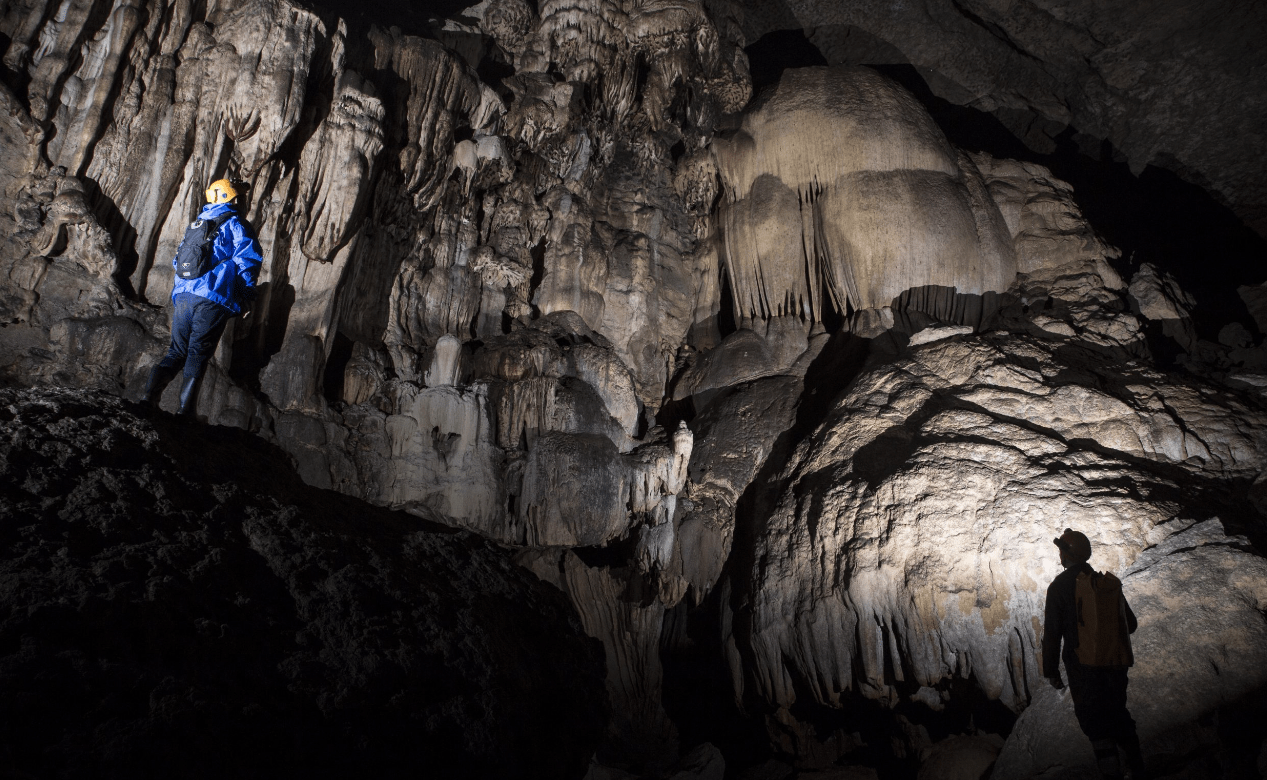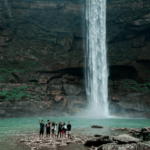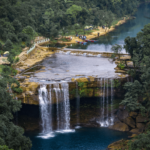Siju Caves: Meghalaya, located in Northeast India, is renowned for its caves. Many of these caves have been naturally sculpted by water interacting with limestone and sandstone, creating stunning formations and unique ecosystems. While some caves in Meghalaya are well-known and attract a steady stream of visitors during peak tourist seasons, numerous others remain unexplored and unmapped. Among these, Siju Cave stands out as one of the earliest explored caves in Meghalaya. Situated in the Garo Hills, Siju Cave is a complex cave system and ranks as one of the longest caves in India.
Siju Cave Complex in Garo Hills, Meghalaya
During our journey through the Garo Hills, we had the opportunity to explore Siju Caves and its surroundings. The Garo Hills are relatively uncharted territory in Meghalaya, with few travelers venturing into this area, possibly due to limited information about it. A few years ago, my interest in experiencing a Garo Festival led me to Tura. The warmth and hospitality of the Garos left a lasting impression on me, and I was eager to return and delve deeper into the Garo Hills.
Where is Siju Cave Located?
Siju Cave is situated in Siju, South Garo Hills, Meghalaya. It can be reached from either Shillong or Guwahati. Unlike Krem Chympe, which requires off-roading and trekking, Siju Cave is accessible by road. It is approximately 255 km from Shillong and 125 km from Tura, the Garo Hills’ administrative center.
Fun Fact: Meghalaya is home to 1580 caves, of which only 980 have been explored.
Krem Liat Prah holds the title of the longest cave in Meghalaya and South Asia, stretching about 30 km.
Siju Cave
Siju Caves are a major highlight of the Garo Hills. Also known as Siju Dobakhol (with Dobakhol meaning cave in the Garo language), the caves are located near Napak Lake and the Simsang River Game Reserve. Like many other caves in Meghalaya, Siju is a limestone cave renowned for its stalactites and stalagmites.
Aerial View of Simsang River, Meghalaya
The Siju Cave system extends over 4 km, though most of the cave is submerged in water, making it inaccessible. Although the local community has been aware of the cave for centuries, it was first explored in 1881 by Mr. T. D. La Touche from the Geological Survey of India, who noted a large bat colony inside. In 1922, a team from the Zoological Survey of India (ZSI) in Kolkata conducted a detailed faunal study of the cave, publishing their findings in several papers.
Water Inside Siju Cave
The exploration documented around 102 living species within the cave, including previously unknown species such as a cave-dwelling shrimp and a new snail species. Later, a ZSI Shillong team studied the bat population in the late 1990s and identified nine bat species residing in the cave. Since then, Siju Cave has been extensively researched and remains one of India’s most thoroughly studied cave systems.
Our Visit to Siju Cave
After visiting Markham Valley and Nongkhnum Island, we planned to drive straight to Siju. However, we underestimated the road conditions near Nongkhnum Island and the time required to explore these locations. Consequently, we arrived in Siju after dark. Most shops in Siju Market were closed, except for a few. We had a quick dinner at a local eatery and proceeded to the Siju Tourist Lodge.
Siju Cave Gate at Siju Market
From the market, a diversion with a clear signpost led us to Siju Cave. The cave is about 5 km from the market area.
The Stay – Siju Tourist Lodge
After driving through roads bordered by areca nut plantations, we reached near the entrance of the Siju Caves. The Tourist Lodge is located right next to the cave. We found a board directing us towards the lodge and saw a wooden bridge that we needed to cross.
Simsang River
However, as we approached the bridge, we discovered that there was no clear path to reach it. A wide trench and a narrow log of wood spanned across it. Given the darkness, walking on the log seemed risky. Instead, we chose to walk along the banks of the Simsang River and hike up a hillock to reach the lodge. We left our luggage in the car and carried only essentials in our backpacks for this detour.
The bridge, which was the original path to the lodge, had been damaged by a flood and landslide in the previous monsoon. The broken bridge and transformer had yet to be fully repaired, and the makeshift bridge was the only option. With few visitors since COVID, the lodge remained partially repaired.
Exploring Siju Cave
The next morning, we were greeted by stunning views of the Simsang River. After breakfast, we set out to explore Siju Caves. An entry ticket costs INR 20 per person.
A newly built adventure park sits beside the caves, and across the road, the inviting blue waters of the Simsang River were visible. Despite the temptation to visit the river first, we decided to proceed with our caving adventure.
Entrance of Siju Cave, Garo Hills, Meghalaya
We approached the cave entrance, which looked formidable. The entrance featured some limestone formations with water dripping down. Inside, a narrow passage led into the depths of darkness, resembling an entry into the earth’s belly or a gigantic anaconda.
Inside the Belly of the Earth
With some apprehension, we entered the cave. A guide is necessary for exploring Siju Cave due to its numerous passages and labyrinthine nature. Without a guide, it’s easy to become lost. The guide also provides insights into the cave’s formations and history.
Limestone Formations Inside Siju Cave, Meghalaya
As we ventured deeper, we were captivated by the cave’s roof and its mesmerizing appearance. The cave grew darker as we progressed, and our headlamps provided limited illumination. We had to navigate through water, which occasionally reached our calves.
Using Headlamps to See Inside Siju Caves
We soon heard a peculiar humming sound and a strong odor—the presence of bats. Siju Cave, also known as the Bat Cave, houses large bat colonies.
Bats Inside Siju Cave, Meghalaya
Our guide directed us to look up, revealing hundreds of yellow glowing dots as our eyes adjusted to the darkness. These were the eyes of countless bats. With our headlamps and mobile torches, we saw thousands of bats hanging from the cave’s roof and flying around. Although the lighting was insufficient for photographs, the experience was unforgettable.
Limestone Formations Inside the Cave
We continued exploring, navigating through water and rocks. Eventually, we retraced our steps, leaving the cave with a sense of awe. We had only explored a small portion of the vast cave system.
Simsang River and Siju Bird Sanctuary
Afterwards, we visited the Simsang River’s banks. Across the river is the Siju Bird Sanctuary, which can be reached by boat. The sanctuary is home to migratory birds like Siberian ducks, Grey hornbills, and spoonbills, as well as endemic species such as hornbills and peacock pheasants. Primates like Hoolock Gibbons, slow lorises, and langurs are also found there.
Siju Bird Sanctuary Across the River
Due to time constraints, we had to skip the bird sanctuary but hoped to return in the future. We spent some time by the river and then proceeded to visit the Rongchang Rock Formation.
Rongchang Rock Formation
The Rongchang Rock Formation features a series of uniquely shaped rocks. Although there was an entry gate and ticket counter, no one was present, so we entered freely and walked down a cobbled path to the formations.
Entrance Gate of the Rongchang Rock Formation
The limestone rocks exhibit various peculiar shapes, some resembling canyons, while others look like giraffes. We explored and marveled at these natural creations. While we wanted to learn more about their formation, no one was available to provide details. It seemed that these formations, like the Siju Cave, were shaped by nature over millions of years.
Rongchang Rock Formation, Meghalaya
This site is often overlooked by visitors heading to Siju Cave. It’s worth a visit if you’re in the area, as it’s conveniently located on the way to the cave.
At Rongchang Rock Formation
After our exploration of Siju, we continued our journey towards Emangre, a small village in South Garo Hills, where we planned to visit Wari Chora the following day.
In Conclusion
Visiting Siju Cave was a fascinating experience. Although caving isn’t my favorite activity, our exploration of offbeat locations in Meghalaya included two caves. While we didn’t explore Chympe Caves, the adventure to it was thrilling. Siju Caves proved to be an interesting destination, complemented by the beautiful Simsang River. It was a memorable trip to Siju before heading to Wari Chora.
Siju Cave Travel Guide
How to Reach Siju Cave?
To visit Siju Cave, travel to either Guwahati or Shillong first. Siju Cave is approximately 200 km from Guwahati and 260 km from Shillong by road. Renting a car from either city is advisable as reliable public transport is limited in the area.
A Bridge on the Way from Shillong to Siju
Alternatively, you can reach Tura, the largest town in the Garo Hills, and then proceed to Siju. Tura is about 125 km from Siju Cave.
**What is the Best Time to Visit?
**
The best time to visit Siju Cave is from October to March when the weather is pleasant. Avoid visiting during the monsoon season as heavy rainfall can make travel challenging.
Where to Stay?
There is limited accommodation in Siju, but the Siju Tourist Lodge offers basic amenities. For a more comfortable stay, consider lodging in Tura, which is about a 3-hour drive away.
Entry Fees:
- Entry to Siju Cave: INR 20 per person
- Siju Tourist Lodge: Rates vary
Nearby Attractions:
- Rongchang Rock Formation
- Simsang River
- Siju Bird Sanctuary (accessible by boat)
Feel free to adjust any details or formatting as needed!


